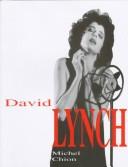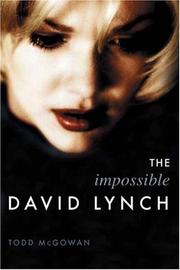| Listing 1 - 7 of 7 |
Sort by
|
Book
ISBN: 0252094050 1283993597 9780252094057 9781283993593 9780252036934 025203693X 9780252078514 0252078519 Year: 2012 Publisher: Urbana : University of Illinois Press,
Abstract | Keywords | Export | Availability | Bookmark
 Loading...
Loading...Choose an application
- Reference Manager
- EndNote
- RefWorks (Direct export to RefWorks)
Discussing the major films of this iconic director, Justus Nieland explores the range of modern design idioms that inform David Lynch's famously cinematic interiors, his work's acute attention to the shaping of affect in particular media environments, and its insistence on the strangeness of biology lived through media.
Lynch, David, --- Lynch, David K. --- Booth, Judas, --- Criticism and interpretation. --- Lynch, David
Book
ISBN: 0292722958 0292744609 0292748892 Year: 2013 Publisher: University of Texas Press
Abstract | Keywords | Export | Availability | Bookmark
 Loading...
Loading...Choose an application
- Reference Manager
- EndNote
- RefWorks (Direct export to RefWorks)
Beginning with Lost Highway, director David Lynch “swerved” in a new direction, one in which very disorienting images of the physical world take center stage in his films. Seeking to understand this unusual emphasis in his work, noted Lynch scholar Martha Nochimson engaged Lynch in a long conversation of unprecedented openness, during which he shared his vision of the physical world as an uncertain place that masks important universal realities. He described how he derives this vision from the Holy Vedas of the Hindu religion, as well as from his layman’s fascination with modern physics. With this deep insight, Nochimson forges a startlingly original template for analyzing Lynch’s later films—the seemingly unlikely combination of the spiritual landscape envisioned in the Holy Vedas and the material landscape evoked by quantum mechanics and relativity. In David Lynch Swerves, Nochimson navigates the complexities of Lost Highway, The Straight Story, Mulholland Drive, and Inland Empire with uncanny skill, shedding light on the beauty of their organic compositions; their thematic critiques of the immense dangers of modern materialism; and their hopeful conceptions of human potential. She concludes with excerpts from the wide-ranging interview in which Lynch discussed his vision with her, as well as an interview with Columbia University physicist David Albert, who was one of Nochimson’s principal tutors in the discipline of quantum physics.
Motion picture producers and directors --- Lynch, David, --- Criticism and interpretation. --- Lynch, David K. --- Booth, Judas, --- Lynch, David

ISBN: 0851704573 Year: 1997 Publisher: London British Film Institute
Abstract | Keywords | Export | Availability | Bookmark
 Loading...
Loading...Choose an application
- Reference Manager
- EndNote
- RefWorks (Direct export to RefWorks)
798.43 --- Lynch, David --- film --- geschiedenis --- regisseurs --- film, geschiedenis der filmkunst, overige landen --- Motion picture producers and directors --- Lynch, David, --- Lynch, David K. --- Booth, Judas,
Book

ISBN: 9789492677624 9492677628 Year: 2018 Publisher: Lichtervelde Maastricht Hannibal Bonnefantenmuseum
Abstract | Keywords | Export | Availability | Bookmark
 Loading...
Loading...Choose an application
- Reference Manager
- EndNote
- RefWorks (Direct export to RefWorks)
David Lynch has always been in the spotlight as a filmmaker, directing some of the most iconic movies ever made, but as a visual artist, he is less widely known. Lynch delights in the physicality of painting and likes to stimulate all the senses in his work. This book brings together Lynch's paintings, photography, drawings, sculpture and installation, and stills from his films. Many of these works reveal the dark underpinnings behind Lynch's often-macabre movies. Others explore his fascination with texture and collage. Throughout, Lynch's characteristic style--surreal, stylish, and even humorous--shines through. An introduction by music journalist and Lynch biographer Kristine McKenna, along with a thought-provoking essay by curator Stijn Huijts, offers fascinating new information and perspectives on Lynch's life and career. This book reveals an unexplored facet of Lynch's oeuvre and affirms that he is as brilliant a visual artist as he is a filmmaker.
Lynch, David --- 7.07 --- Beeldende kunst ; 1980-2018 ; David Lynch --- Lynch, David °1946 (°Missoula, Montana, Verenigde Staten) --- Kunstenaars met verschillende disciplines, niet traditioneel klasseerbare, conceptuele kunstenaars A - Z --- Lynch, David, --- Lynch, David K. --- Booth, Judas, --- Exhibitions
Book
ISBN: 9781472508812 9781472505484 9781472520234 1472505484 1472508815 1472520238 1472586433 9781472586438 Year: 2020 Publisher: London, England : London, England : Bloomsbury Academic, Bloomsbury Publishing,
Abstract | Keywords | Export | Availability | Bookmark
 Loading...
Loading...Choose an application
- Reference Manager
- EndNote
- RefWorks (Direct export to RefWorks)
"Home to some of the most remarkable spaces in contemporary culture, the cinema of David Lynch demonstrates an acute awareness of architecture. From the urban wastelands of Eraserhead to the eerie Red Room in Twin Peaks, Lynch's architecture is anxious, absurd and utterly distinct. Contemporary architects such as Peter Eisenman, Frank Gehry and Jean Nouvel have responded to these spaces in fascinating ways. This book is the first sustained critical assessment of the role architecture and design play in Lynch's films. What can be learnt about Lynch's films by examining the architecture we see within them? What can be learnt about architecture, especially the spatial developments of post-war America, by examining Lynch's films?Drawing on primary research in íódź, London, Los Angeles, Paris and Philadelphia, the book is structured around the prime symbolic spaces found in Lynch's work: the small town, the city, the home, the road, and the stage. A final chapter deals with the singular architecture of Lynch's latest film, Inland Empire, a complex work yet to receive sufficient critical explication. Alongside a broad set of literary, cinematic and artistic comparisons, a diverse range of urban and architectural theorists, including Mike Davis, Jane Jacobs and Richard Sennett, are discussed in a new context. The Architecture of David Lynch will emphasise key architects such as Rem Koolhaas, Le Corbusier, Adolf Loos, Richard Neutra, Jean Nouvel and Frank Lloyd Wright to show how Lynch's films enable us to understand contemporary architecture and demonstrates that Lynch's work prompts a reconsideration of how European modernism has been translated across the Atlantic"--
motion pictures [visual works] --- Film --- Architecture --- architecture [object genre] --- Lynch, David --- ARCHITECTURE --- ART --- Architecture in motion pictures. --- DESIGN --- Motion pictures and architecture. --- Criticism. --- General. --- Film & Video. --- Lynch, David, --- Criticism and interpretation. --- Architecture and motion pictures --- Motion pictures --- Lynch, David K. --- Booth, Judas, --- Architecture in motion pictures --- Motion pictures and architecture --- Lynch, David, - 1946- - Criticism and interpretation
Book
ISBN: 9783791384702 3791384708 Year: 2018 Publisher: Munich Prestel Verlag
Abstract | Keywords | Export | Availability | Bookmark
 Loading...
Loading...Choose an application
- Reference Manager
- EndNote
- RefWorks (Direct export to RefWorks)
"David Lynch is best known for his work as a filmmaker, directing some of the most iconic movies in American history. His output as a visual artist is less widely known. This revelatory book brings together some of the most striking examples of Lynch's paintings, drawings, photographs, installations, film stills, and sculptures. Many of these works reveal the dark underpinnings behind Lynch's often macabre films and television series. Others explore his fascination with texture and collage. Edited by Stijn Huijts and introduced by David Lynch's biographer, Kristine McKenna, along with insightful texts by Michael Chabon and Petra Giloy-Hirtz. This book reveals an unexplored facet of Lynch's oeuvre and affirms that he is as brilliant a visual artist as he is a filmmaker."
Art, American --- Surrealism --- Avant-garde (Aesthetics) --- Male artists --- 7.07 --- Beeldende kunst ; 1980-2018 ; David Lynch --- Lynch, David °1946 (°Missoula, Montana, Verenigde Staten) --- Men artists --- Artists --- Aesthetics --- Modernism (Art) --- Superrealism --- Surrealism in art --- Arts, Modern --- Kunstenaars met verschillende disciplines, niet traditioneel klasseerbare, conceptuele kunstenaars A - Z --- Lynch, David, --- Lynch, David K. --- Booth, Judas, --- Criticism and interpretation. --- Themes, motives. --- Exhibitions --- Art --- Lynch, David

ISBN: 9780231139540 9780231139557 0231139543 0231139551 Year: 2007 Volume: *10 Publisher: New York, N.Y. ; Chichester : Columbia University Press,
Abstract | Keywords | Export | Availability | Bookmark
 Loading...
Loading...Choose an application
- Reference Manager
- EndNote
- RefWorks (Direct export to RefWorks)
Lynch, David --- Motion picture producers and directors --- Producteurs et réalisateurs de cinéma --- Lynch, David, --- Criticism and interpretation. --- Influence. --- #SBIB:309H1323 --- #SBIB:309H520 --- film --- filmregisseurs --- filmgeschiedenis --- filmtheorie --- Verenigde Staten --- Lynch David --- 791.471 LYNCH --- Films met een amusementsfunctie en/of esthetische functie: auteurs --- Audiovisuele communicatie: algemene werken --- Lynch, David K. --- Booth, Judas, --- Producteurs et réalisateurs de cinéma --- Criticism and interpretation --- Lynch, David (1946-....) --- Critique et interprétation
| Listing 1 - 7 of 7 |
Sort by
|

 Search
Search Feedback
Feedback About UniCat
About UniCat  Help
Help News
News